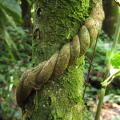
dysfunctional word machine

Posts: 1831 Joined: 15-Mar-2014 Last visit: 26-Mar-2025 Location: at the center of my universe
|
To me it doesn't look much like phragmites spp.
But downwardsfromzero is right in the sense that close up pictures of certain morphological details are needed for a more definitive and dependable determination.
|
|
|
|
|

Boundary condition

Posts: 8617 Joined: 30-Aug-2008 Last visit: 24-Dec-2025 Location: square root of minus one
|
pitubo wrote:To me it doesn't look much like phragmites spp.
But downwardsfromzero is right in the sense that close up pictures of certain morphological details are needed for a more definitive and dependable determination. If I may clarify, photos of the flowers are highly reminiscent of Phragmites australis to me in that they appear to have a purplish colour and a very similar overall form. That might just be the way the shots were taken. The stature of the plants is very unlike the common reed, and the leaves are rather too much on the glossy side. (Which maybe I could have said in the first place.) Details maketh plant taxonomy. “There is a way of manipulating matter and energy so as to produce what modern scientists call 'a field of force'. The field acts on the observer and puts him in a privileged position vis-à-vis the universe. From this position he has access to the realities which are ordinarily hidden from us by time and space, matter and energy. This is what we call the Great Work." ― Jacques Bergier, quoting Fulcanelli
|
|
|
DMT-Nexus member
Posts: 26 Joined: 13-Jan-2013 Last visit: 09-Dec-2020 Location: Australia
|
Hi guys! The last couple of pages have been great: I think I've finally gotten P. Arundinacea identification and differentiation from D. Glomerata and Phragmites Australis down after your many helpful posts, but as the grass isn't flowering here just yet I've started looking towards P. Aquatica, P. Paradoxa, P. Brachystachys and P. Minor for extended testing. I am hoping what I have here could possibly be P. Paradoxa. I found this growing by an incredibly dirty lake (I live in desert Aus) in soft, marshy soil with other clumps the same size; I couldn't see any larger or taller specimens. I pulled one whole clump out (easy enough in the mud, I was sinking 5-10cm each step) and repotted it at home, not in hopes of having any usability out of it but just to find out more about this particular grass. The seed heads are throwing me off slightly, as they look "fluffier" than paradoxa or indeed any Phalaris species. Everything else seems to match though, and I apologise for the crappy photos...still investing in a good camera! :/ Unfortunately my grass ID skills beyond Phalaris are even more woeful so it could very likely not be a Phalaris at all! NB: The small first year Rue plants in the first pic. ;3 LowHP attached the following image(s):  1.jpg (925kb) downloaded 283 time(s). 2.jpg (833kb) downloaded 281 time(s). 4.jpg (545kb) downloaded 283 time(s). 3.jpg (488kb) downloaded 281 time(s).
|
|
|

DMT-Nexus member
 
Posts: 12340 Joined: 12-Nov-2008 Last visit: 02-Apr-2023 Location: pacific
|
I am not personally familiar with Paradoxa, so my comment here is of limited value..however that does not resemble any of the phalaris species I have worked with. Long live the unwoke.
|
|
|

It is no measure of health to be well adjusted to a profoundly sick society. Jiddu Krishnamurti
Posts: 39 Joined: 05-Sep-2015 Last visit: 29-Nov-2021
|
downwardsfromzero wrote:[quote=dreamer042]That one appears to be P. arundinacea Are you sure? It looks so similar to lya's pictures above it that were ID'd as Dactylis glomerata. Although the ligule does appear more diaphanous on LowHP's specimen. I've attached the pics as requested, let me know what you think. sham attached the following image(s):  IMG_0966.JPG (1,377kb) downloaded 257 time(s). IMG_0967.JPG (746kb) downloaded 259 time(s). IMG_0968.JPG (829kb) downloaded 258 time(s). IMG_0969.JPG (1,039kb) downloaded 258 time(s).[color=red]Our world is in crisis because of the absence of consciousness. To whatever degree any one of us can bring back a small piece of the picture and contribute it to the building of the new paradigm, then we participate in the redemption of the human spirit.
[/color]
TMK
|
|
|

Dreamoar

Posts: 4711 Joined: 10-Sep-2009 Last visit: 27-Dec-2025 Location: Rocky mountain high
|
|
|
|

It is no measure of health to be well adjusted to a profoundly sick society. Jiddu Krishnamurti
Posts: 39 Joined: 05-Sep-2015 Last visit: 29-Nov-2021
|
 [color=red]Our world is in crisis because of the absence of consciousness. To whatever degree any one of us can bring back a small piece of the picture and contribute it to the building of the new paradigm, then we participate in the redemption of the human spirit.
[/color]
TMK
|
|
|

Suffering insomnia and sleep deprivation, assume I am halucinating and nothing I say is true.
Posts: 8 Joined: 16-Apr-2016 Last visit: 20-May-2016
|
This thread has been very helpful, thanks to all who contributed - even the negatives help clear the picture. I'm pretty sure I have been pulling P. Aquatica (Australian) out of the garden for years. Whatever this is, its treated as a weed here. Can anyone please identify? Imagineer Hat attached the following image(s):  Grass 1.jpg (3,887kb) downloaded 230 time(s). Grass 2.jpg (4,262kb) downloaded 230 time(s). Grass 3.jpg (3,912kb) downloaded 232 time(s). Grass 4.jpg (3,843kb) downloaded 230 time(s). Grass 5.jpg (3,783kb) downloaded 228 time(s).Never trust anyone who says "trust me".
I made it all up, trust me.
|
|
|

DMT-Nexus member

Posts: 337 Joined: 10-May-2014 Last visit: 06-Jul-2025
|
Low HP, nothing even remotely close to Phalaris!
That is "Rabbit Foot Grass" or Polypogon Monspeliensis, it's been mentioned a few times previously in this thread. That is flowering right now(April-May) where I am. I assume if it is flowering in January based on the date of your post, then P. Aquatica(if available in your vicinity) would likely begin flowering in February or March. No alkaloids in Polypogon that I'm aware of.
Sham, I haven't had a chance to hang out with Johnson Grass since last fall but I would bet that it is either Johnson Grass(Sorghum Halepense) or some sort of Panicum...Possible 5-Meo-DMT in roots or foliage of Sorghum(ref. Some Simple Tryptamines by Trout). Careful with Sorghum if you plan for extraction because there are possible "nasties" in there. I also would point out that a root extraction is extremely messy and borderline pointless unless you have thoroughly cleaned them. After an hour or two of doing that plus extraction time and yielding only fats and weird goo, might think twice. Phalaris is O.G.
Edit: I took a peek at the photos you posted on the page previous to this, and that is a huge stand of Johnson Grass 100%$ positive. They are so freaking invasive it's nuts. The seeds are edible and common in bread and bird feed.
Imagineer Hat, YOU HAVE PHALARIS AQUATICA!
|
|
|

Suffering insomnia and sleep deprivation, assume I am halucinating and nothing I say is true.
Posts: 8 Joined: 16-Apr-2016 Last visit: 20-May-2016
|
Quote:Imagineer Hat, YOU HAVE PHALARIS AQUATICA! Thanks Chimp Z, I thought as much  I recently had a dream about it which was so vivid I will post some notes in a new thread. Never trust anyone who says "trust me".
I made it all up, trust me.
|
|
|
DMT-Nexus member
Posts: 2 Joined: 30-Jul-2016 Last visit: 30-Jul-2016
|
Hello and salutations brother's of this physical plane. I am new here, and to DMT in general. I have yet to undergo my transformation but have had plenty EXP with Mescaline cacti, LSD, and LSA containing seeds. In my research I found that many strains of reed contain decent to minuscule amounts of the "spice" as we call it but in my studies only found that in depth analysis has only been done on a few species primarily being the phalaris arunduncea. Now then allow me to get straight into the point of this post. Im fortunate enough to live in sunny South Florida and have many water ways and canals around my property so obviously I decided to partake in a DMT containing flora hunt and acquired around a pound or maybe a pound and a half of some Phalaris genus type. I have skimmed forum post to forum post in search of some insight but to my dismay.. have found nothing. So now to you guys of the Nexus I ask you for some help in trying to I.D. my strain to possibly get my extract underway assuming it isn't a strain containing and neurotoxic compounds mickzero attached the following image(s):  20160729_190439.jpg (1,990kb) downloaded 201 time(s). 20160729_190512.jpg (2,269kb) downloaded 202 time(s).
|
|
|

Dreamoar

Posts: 4711 Joined: 10-Sep-2009 Last visit: 27-Dec-2025 Location: Rocky mountain high
|
That does not appear to be Phalaris. I'm no expert, but the closest I could find with a quick google suggests a species of fountain grass.
|
|
|
DMT-Nexus member
Posts: 2 Joined: 30-Jul-2016 Last visit: 30-Jul-2016
|
Thanks for merging my post into this one as there is tons of info in here  and thank you for the response I guess my hunt continues.... until I eventually cave in and just order some M. Hostilis
|
|
|

DMT-Nexus member

Posts: 337 Joined: 10-May-2014 Last visit: 06-Jul-2025
|
Mickzero, that's Rabbit-foot grass
|
|
|

DMT-Nexus member
Posts: 239 Joined: 26-Jun-2011 Last visit: 13-Mar-2024
|
hello fellow nexians  could someone give me an ID of this grass please? thank you MultiDimensionalTherapy attached the following image(s):  IMG_5808.JPG (2,631kb) downloaded 161 time(s). IMG_5811.JPG (2,461kb) downloaded 161 time(s). IMG_5812.JPG (2,220kb) downloaded 161 time(s). IMG_5814.JPG (2,366kb) downloaded 161 time(s).Healing someone is an act of love, but how can you love someone whitout loving yourself first?
|
|
|

DMT-Nexus member
Posts: 1903 Joined: 15-Mar-2014 Last visit: 13-Dec-2025
|
MultiDimensionalTherapy wrote:hello fellow nexians  could someone give me an ID of this grass please? thank you That seems to be some species of Carex. Possibly binervis? 'What's going to happen?' 'Something wonderful.'
Skip the manual, now, where's the master switch?
We are interstellar stardust, the re-dox co-factors of existence. Serve the sacred laws of the universe before your time comes to an end. Oh yes, you shall be rewarded.
|
|
|
DMT-Nexus member
Posts: 2 Joined: 07-Apr-2017 Last visit: 19-Aug-2018 Location: The Outer Rim
|
Im in the great state of north carolina and of course now i make my attempt to find phalaris arundinacea, as opposed to when I lived up north in eastern shore, Md. During my third walk to find it stumbled upon a large grass in flower, almost appears to be ready to drop seeds. This one of course is right by the road and upon checking the area for more, discovered a vast field of very large grasses, all of them appear the same. These werent in flower and had the appearance of ornamental grasses. Regardless of if they are thought to be p. Arundinacea or Toros mired as I am going to ab extract in the name of science. So of course i ask, what kind of grass do you believe this to be, if you can tell. Thanks friends, Q Quessia attached the following image(s):  20170816_172213.jpg (3,822kb) downloaded 144 time(s).
|
|
|

DMT-Nexus member
Posts: 1111 Joined: 18-Feb-2017 Last visit: 12-Jul-2024
|
I came across these today. They grew in clumps, but some clumps had these fat inflorescences (first 2) while other clumps had the sparse ones (last 2). Both types of clumps grew in the same area and next to each other. I first thought both were Phalaris aquatica, but at different stages of maturity. Now I'm almost sure the first type (first 2 images) is not P. aquatica. But what about the second? Type 1:   Type 2:  
|
|
|

DMT-Nexus member

Posts: 337 Joined: 10-May-2014 Last visit: 06-Jul-2025
|
NONE OF THE RECENT PICTURES POSTED ARE OF ANY SPECIES OF PHALARIS OR KNOWN TRYPTAMINE GRASS. KEEP SEARCHING!! U WILL FIND IT     
|
|
|

DMT-Nexus member
Posts: 1111 Joined: 18-Feb-2017 Last visit: 12-Jul-2024
|
Thanks Chimp Z. This grows by a lake near me, it's much taller than the other grasses, more like a reed. Any chance it could be a Phalaris species?  
|